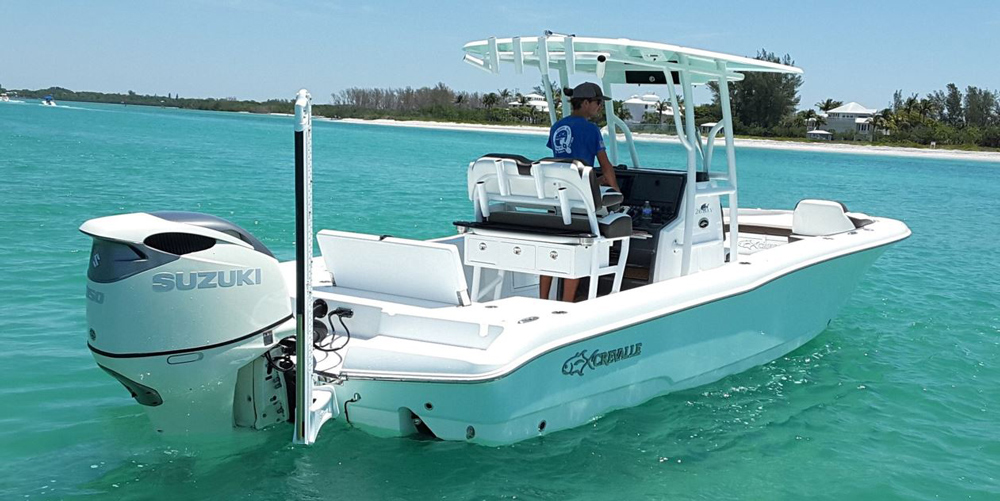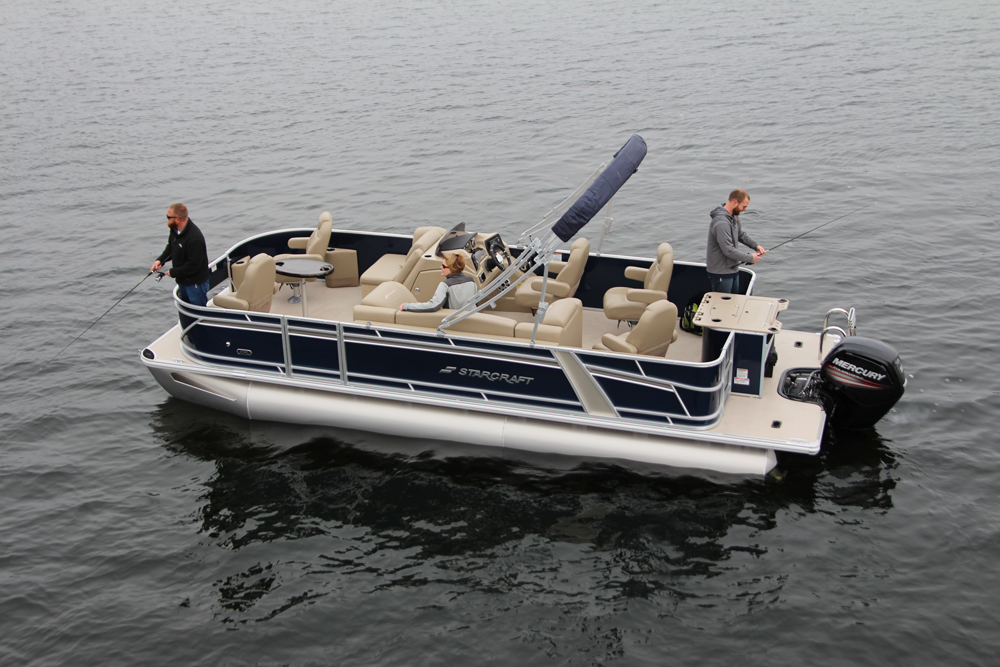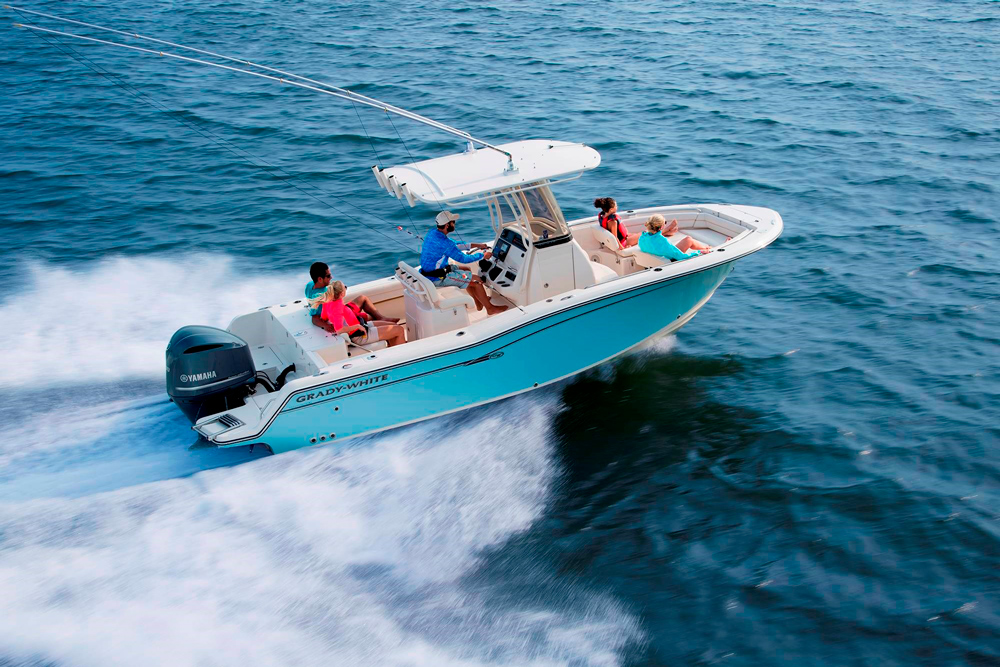Center console boats are the best because they maximize fishability, but dual console boats are the best boats because they allow for more versatility, but boats with cabins are the best boats because they have additional protection, but… but… but… You get the message – there’s really no such thing as “best” when it comes to boats. There’s only what’s best for you, personally, and that may be quite different than what’s best for someone else. So, how are you supposed to pick between all those shiny new fiberglass hulls you see when you go to the Baltimore boat show this winter? It won’t be an easy choice no matter what you do, but we can help. As you go boat shopping, remember:
Bay Boats
Developed down south, this style has just recently have become popular in our area, and they're ideal for light tackle casting and jigging. Most are also designed purely for angling and thus have gobs of livewell capacity, tons of rodholders, and lots of other angling accouterments. Their low sides mean less windage and an easier reach to the water, while their lower deadrise hulls tend to have excellent stability. But on the flip side of the coin some can be rather wet, and others a bit bumpy when the seas kick up.

Center Consoles
Center consoles are the ultimate in fishability, but they’re also the ultimate in exposure. If you plan to take your four-year-old out for a day of trolling for trophy stripers on a chilly, drizzling day in April, that open exposure can lead to utter misery. One exception: today’s larger center consoles are sometimes substantial enough to support a cabin inside the console. Boats of this size, however, are naturally far more expensive than the 20-something center consoles most prolific on the Bay.
Cabin Boats
Cuddy Cabin and Pilot House boats trade off fishability in the bow for vastly improved protection and comfort. While cabin boats may not be ideal for light tackle casting, they’re still pretty darn good. And truth be told there’s zero sacrifice when it comes to trolling. So many people who enjoy trolling, including in adverse weather, opt for that full cabin enclosure. Walkarounds essentially offer the same advantages as those cuddy and pilothouse boats. But thanks to a deep sidedeck and easier walks forward and aft, they recoup a bit of fishability on the bow. The downside here is that the sidedecks eat into cabin space.
Convertibles
Flybridge boats gain a huge visibility advantage thanks to their elevated helms, which are a serious boost for offshore anglers. They also tend to have big, open cockpits which are excellent for trolling. But their large size means they’re also expensive to buy and expensive to run. Plus, most flybridge boats aren’t well-suited to light tackle fishing.
Dual Console Boats
Dual Consoles have a bit more protection than a center console, but more significantly they’re also pretty good platforms for watersports like water skiing and wakeboarding. Yes, you’ll usually lose some fishing space aft due to extra seats and maybe a wet-bar. And the windshield and/or top doesn’t allow for 360-degree fishing all around the boat. But the flexibility they provide means that they’re the choice of many people who have interests more varied than merely fishing, fishing, and more fishing. (Hmmm, what’s wrong with those folks?!)
Pontoon Boats
Pontoon Boats often get dismissed a little to quickly, by saltwater anglers. No, they aren’t ideal for big open waters with large waves. But their huge rectangular decks, high stability, and luxurious seating can make flounder angling in a coastal bay or perch-jerking in a river shockingly comfortable.

Fishing Boat Hull Designs
Once you’ve picked out a genre of boat, it’s time to take a closer look at the hull design. This will determine how the boat acts when you’re off the dock, and has a huge impact on how happy you will or will not be with it.
Transom Deadrise
Transom Deadrise is the amount of “V” in the hull, measured all the way aft. In a nutshell, more deadrise generally equates to a smoother ride through rough seas. But as deadrise goes up so does rocking and rolling, because the lower deadrise is, the more stable a hull tends to be. Hulls with 21 to 24 degrees of deadrise are generally considered deep-Vs, those with 10 to 20 degrees are semi-Vs, and those with less deadrise are moderate-Vs. Variable-degree deadrise boats have a V that transitions through different angles, from bow to stern. And boats with no deadrise at all are flat-bottom boats.

Cat Hulls
Powercat Hulls can provide the ultimate in smooth rides, as they ride atop a cushion of compressed air in the tunnel. However, they also can suffer from a fast, uncomfortable, snappy roll; many lean outwards when turning; some create a puff of mist called a “sneeze” that blasts out of the tunnel (and gets everyone aboard damp); and others suffer from uncomfortable “tunnel slap” (when the top of the tunnel hits the waves) in certain conditions. All in all people that can’t stand a pounding love them, while many other anglers can’t stand them.
Boats With Steps
Stepped Hulls have bottoms which create areas of low pressure under the boat and have notches in the hullsides to allow air to flow into those areas. By reducing wetted surface they reduce drag, boosting speed and efficiency. When properly designed they can provide excellent performance. When poorly designed they can lead to unpredictable handling.
Other Hull Designs
Unique Hulls that don’t fit neatly into any of these categories are out there, too. Bayliner’s M-Hull, Mako’s Inverted V, and Aspen’s Proa hulls are all good examples of designs that have their own individual form. Each has its own strengths and weaknesses – just like any other hull design that’s ever made it from the drawing board onto the water.
Okay: are you ready to go boat shopping? We certainly hope so – and we hope you find that perfect boat, for you and your family.